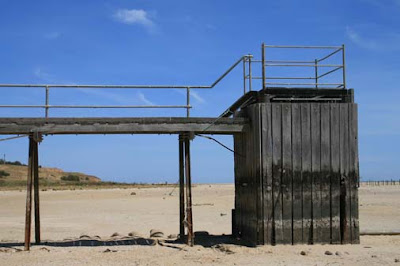The bund between Lakes Alexandrina and Albert, on 22nd Jan 09 (western calendar).
During the record heatwave at the end of Jan-beginning of February and strong winds, a marked difference is seen. Images 5th February 09:
The bund, we were told in April 08 by the SA Govt, would be "temporary" for 6 months.
Thirteen "temporary" pumps were replaced by 3 "permanent" pumps. Now there are 6, pumping day and night.
The record heatwave conditions, we are told, is responsible for the increased pumping from Lake Alexandrina into Lake Albert to avoid its ecological collapse.
Notice the colour of the water being pumped.
On still nights, reverberations from the pumps echo across the lake. The constant jerky low frequency sound is torturous and is causing sleep deprivation for this resident of Narrung.
A stagnant pool of water is trapped by build-up of silt beside the bund.
The bund is already showing serious cracks and subsidence.


With all the pumping and silting, the Narrung Ferry is out of water to cross.
 Diving off the Narrung jetty is no longer advisable.
Diving off the Narrung jetty is no longer advisable.

 Willows growing at the Narrung Ferry approach are out of water.
Willows growing at the Narrung Ferry approach are out of water.


 Introduced weed species, feathers, corpses, cracks aresalient signs of the environmental distress.
Introduced weed species, feathers, corpses, cracks aresalient signs of the environmental distress.

 Silts, showing high levels of salinity, have been dumpedon habitat where Australian otters and swamphens used to live.What is likely to grow here?
Silts, showing high levels of salinity, have been dumpedon habitat where Australian otters and swamphens used to live.What is likely to grow here?  When the wind blows, dust from the Narrung wetlands fills our gutters. Frequent cleaning is causing costly repairs. A local doctor suspects drinking water of Narrung residents has been contaminated by the dust, causing health problems
When the wind blows, dust from the Narrung wetlands fills our gutters. Frequent cleaning is causing costly repairs. A local doctor suspects drinking water of Narrung residents has been contaminated by the dust, causing health problems.


In 2008, environmental work was carried out to help restore the Narrung wetland. Due to lack of flows down the river it is now dust,
gone the swans, spoonbills, stilts, sandpipers, egrets, terns and frogs.
 The lower lakes and Coorong, the lungs of the River Murray, maintained by the Ngarrindjeri for thousands of years as an abundant delta, supporting the densest pre-Invasion population on this continent, are now being sacrificed to the greed of the Australian nation
The lower lakes and Coorong, the lungs of the River Murray, maintained by the Ngarrindjeri for thousands of years as an abundant delta, supporting the densest pre-Invasion population on this continent, are now being sacrificed to the greed of the Australian nation.
Shame!
pics: © Vesper Tjukonai Feb 2009






























































